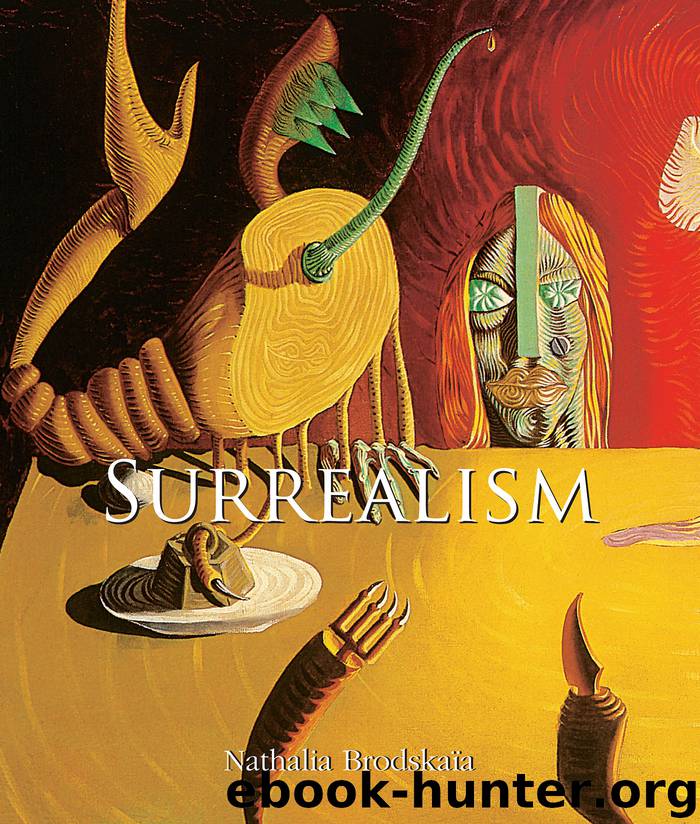Surrealism by Natalia Brodskaïa

Author:Natalia Brodskaïa [Brodskaïa, Natalia]
Language: eng
Format: epub
ISBN: 9781683254737
Publisher: Parkstone International
Joan Miró, The Table (Still Life with Rabbit), 1920. Oil on canvas, 130 x 110 cm. Private collection.
Joan Miró (1893-1983)
Joan Miró loved Catalonia. All his life he painted its dazzling blue sky. It is difficult to say whether, in the body of work Miró has left us, there is even one picture without the sun. Wherever he worked, whether in a Paris studio or on the island of Majorca, the colour and light of Catalonia always remained in his painting.It was light, colourful and transparent.
I am overwhelmed when, in an immense sky, I see a crescent moon or the sun, said Miró. Indeed, what my pictures have are tiny forms in big, empty spaces, empty horizons, empty plains, everything which is stripped down has always impressed me very much.[79]
Miró did not come to Surrealism by accident. Everything he created is a dream. Sometimes it is incomprehensible and disturbing, like any dream. But more often it is happy, with child-like purity and naivety.
Joan Miró was born on 20 April 1893 in Barcelona. He was the first-born child of Miguel Miró Adzerias, a goldsmith and watchmaker, and Dolores Ferra, daughter of a cabinet-maker from Palma on the island of Majorca. In his family, where fine and serious work was appreciated more than anything, he acquired the skills of a craftsman and the habit of going deeply into a problem in order to find the right solution to it. “I work like a gardener or a wine-grower”, Miró said. “Things come slowly. My vocabulary of forms, for example, is not something I discovered straight away. It was formed almost in spite of myself.”[80] Miró was not conspicuously successful at school, and what mattered most to him began after the lessons, in drawing classes.
That class for me was like a religious ceremony, he recalled. I carefully washed my hands before touching the paper and pencils. The instruments I used for working became sacred objects for me and I worked as though I were performing a religious rite.[81]
His parents sent him to commercial school, but he put all his effort into his drawing at the art school in Lonja. His teachers taught him according to the classical system, but Miró preferred folk art. “Popular art always moves me”, he later said. “There is nothing tricky or phoney about this art. It goes straight to the point. It surprises, and it is so rich in possibilities.”[82] When he reached the age of seventeen, his parents insisted that he should work in the Barcelona trading firm of Dalmau Oliveras. Miró was obliged to abandon art school. When he became seriously ill, his parents sent him to their house in Montroig, a village on the Tarrogne plain. There he was able to devote himself completely to painting. In 1912, Miró enrolled at the Escola d’Arte de Francisco Gali in Barcelona, and simultaneously studied at the Académie libre du dessin du Cercle Saint Luc. There he met Joan Prats, who became his best friend. Miró entered a circle of young artists.
Download
This site does not store any files on its server. We only index and link to content provided by other sites. Please contact the content providers to delete copyright contents if any and email us, we'll remove relevant links or contents immediately.
4 - Harry Potter and the Goblet of Fire by J.K. Rowling(2612)
2010-The City & the City by China Miéville(1910)
Wall and Piece by Banksy(1749)
Thank You for Being Late by Thomas L. Friedman(1704)
The Mirror and the Light by Hilary Mantel(1596)
Journey to the Abyss by Harry Kessler(1571)
The Old Farmer's Almanac 2020 by Old Farmer’s Almanac(1567)
The Andy Warhol Diaries by Andy Warhol(1530)
Tolkien, J. R. R. - The Fellowship of the Ring by Tolkien J. R. R(1435)
Life on Earth by David Attenborough(1395)
Art Nouveau by Carol Belanger Grafton(1366)
The Museum Of Innocence by Orhan Pamuk(1354)
Harry Potter - A History of Magic by British Library(1346)
The Business of Being an Artist by Daniel Grant(1315)
Frida by Hayden Herrera(1257)
The Future Is Japanese by(1245)
Impeach by Neal Katyal(1218)
A History of Japanese Art by Noritake Tsuda(1175)
1215 by Danny Danziger(1133)
